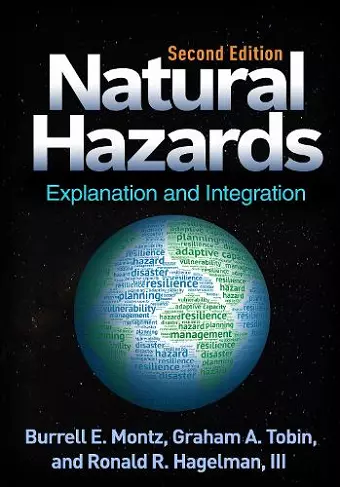Natural Hazards, Second Edition
Explanation and Integration
Graham A Tobin author Burrell E Montz author Ronald R, III Hagelman author
Format:Hardback
Publisher:Guilford Publications
Published:10th May '17
Currently unavailable, and unfortunately no date known when it will be back
This hardback is available in another edition too:
- Paperback£56.99(9781462529179)

What can we learn from the spatial patterns of disasters? What human and structural factors need to be addressed to explain hazard vulnerability? As populations grow and the climate warms, how can natural hazards be mitigated? Thoroughly revised and updated, and now with a more global perspective, the second edition of this accessible text provides an integrated framework for understanding and managing natural hazards. Numerous case studies from around the world illustrate the complexities of extreme geophysical events and highlight their physical, social, political, and economic dimensions. The text identifies essential principles for tackling the fundamental causes of differential vulnerabilities that perpetuate human distress, and for promoting recovery and resilience.
New to This Edition
*New frameworks for understanding human resilience and adaptive capacity in recovery, dynamics of risk and uncertainty, and more.
*Chapter on spatial and temporal aspects of hazards.
*Discussions of cutting-edge topics, such as chronic disasters, controversies in international aid, and how hazards affect regions differentially.
*Many new case studies, including Hurricanes Katrina and Charley, Superstorm Sandy, the 2011 Japan tsunami, Ecuador's chronic volcanic hazard, and others.
*Reflects 20 years of research advances across the physical and social sciences, development trends, new technologies, and ongoing global climate change.
"A welcome update. Maintaining the original framework, the second edition of this text integrates the temporal and spatial aspects of hazards while eschewing a hazard-by-hazard approach. Synthetic in nature, the examples bridge the physical, social, and behavioral sciences, and reflect important advances in thinking about vulnerability as well as newer concerns such as climate change. More than just descriptive, Natural Hazards provides clear prescriptions for reducing vulnerability to disastrous events. I look forward to using this text in my upper-level undergraduate hazards course."--Jerry T. Mitchell, PhD, Department of Geography, University of South Carolina
"This is the most comprehensive and up-to-date text on the nature and mitigation of natural hazards. It approaches natural disasters by focusing on their root causes, including hazard perception and behavior, topics missing from most current texts. The book presents a model of risk that strikes a balance between the physical mechanisms and the human dimension of natural hazards and considers available coping strategies as an essential element. I plan to adopt this text for my class."--Qian Guo, PhD, Department of Geography and Environment, San Francisco State University
"Montz, Tobin, and Hagelman use the lenses of both the physical and social sciences to provide an interdisciplinary examination of a multifaceted topic. The book describes the relationship of humans to natural hazards at multiple scales--from individuals to communities to nations--while being ever mindful that knowledge should serve as a basis for action. The book is filled with international examples, as well as dozens of charts and tables that measure hazards and vulnerability in every way possible. This comprehensive and readable review is the most complete introduction I know of to this field."--Robert B. Olshansky, PhD, FAICP, Department of Urban and Regional Planning, University of Illinois at UrbanaChampaign
"This particularly rich volume brings together three outstanding scholars dedicated to reducing loss of life, property damage, and expenses related to disasters. Expertly combining an understanding of physically situated risks and their related human impacts, the text walks readers through how and why natural hazards create disasters. It is deeply embedded in evidence-based best practices and well poised to generate theoretical and practical insights."--Brenda Phillips, PhD, Associate Dean and Professor of Sociology, Ohio University–Chillicothe
"Combining the study of physical features of natural hazards with the complicated role of human interaction, this 'must-read' book offers a unique perspective for all emergency managers, regardless of specialty. It provides the best summary of where the field has been, highlights past lessons learned from national and international disasters, and discusses the current accepted cycle of recovery. The critique of governmental entities at the local, state, and federal levels, and the emphasis on positive public policy support of mitigation practices and risk reduction–focused leadership, also make this a valuable book for public administrators."--Charla Marchuk, MPA, CFM, natural hazards specialist, Denton, Texas
ISBN: 9781462529186
Dimensions: unknown
Weight: 1034g
445 pages
2nd edition